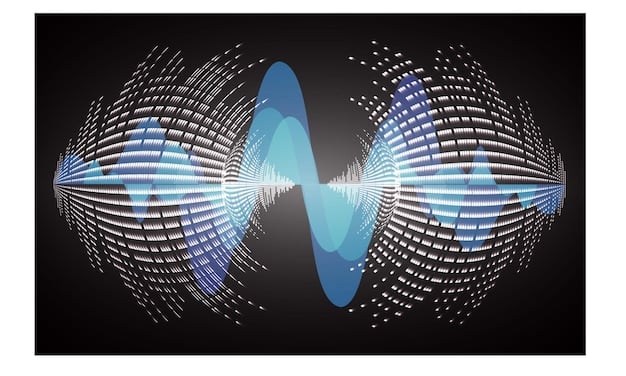Binaural Beats for Focus: A Guide to Home Office Concentration

Unlocking Peak Focus: A Deep Dive into Binaural Beats for Home Office Concentration explores how specific sound frequencies can enhance focus and cognitive function, making them a powerful tool for improving productivity in the home office.
Struggling to concentrate in your home office? Discover how Unlocking Peak Focus: A Deep Dive into Binaural Beats for Home Office Concentration might be the key to a more productive and focused work environment.
What are binaural beats and how do they work?
Binaural beats are auditory illusions perceived when two different tones of slightly different frequencies are presented to each ear. The brain then perceives a third tone, the “binaural beat,” which is the difference in frequency between the two tones. This phenomenon has been studied for its potential to influence brainwave activity and cognitive states.
The concept is simple: listen to two slightly different frequencies through headphones, and your brain interprets the difference as a distinct tone. This tone isn’t actually present in the external sound; it’s created by your brain itself. This is what makes binaural beats unique compared to other forms of sound therapy.

The science behind the beats
Scientific research suggests that binaural beats can influence brainwave patterns. Different frequencies are associated with different states of consciousness and cognitive function. For example, beta frequencies (12-30 Hz) are associated with alertness and focus, while alpha frequencies (8-12 Hz) are linked to relaxation and creativity.
How binaural beats affect the brain
When you listen to a binaural beat, your brain attempts to synchronize its own electrical activity with the presented frequency. This process, known as brainwave entrainment, can potentially shift your mental state towards the desired state. In the context of home office concentration, specific binaural beat frequencies can help promote a more focused and alert mindset.
- Brainwave entrainment occurs when the brain’s electrical activity synchronizes with an external stimulus.
- Different binaural beat frequencies are associated with different mental states.
- Specific frequencies can promote focus, relaxation, or creativity.
In summary, binaural beats work by creating an auditory illusion that can influence brainwave patterns, potentially leading to enhanced focus and concentration. This makes them an appealing tool for boosting productivity in the home office.
Benefits of binaural beats for your home office
The benefits of using binaural beats in a home office environment are wide-ranging, offering potential improvements in focus, stress management, and overall cognitive performance. By influencing brainwave activity, these auditory stimuli can assist in creating an optimal mental state for productive work.
One of the primary benefits is improved concentration. By listening to binaural beats within a specific frequency range (typically beta frequencies), individuals can increase their focus and attention span, reducing distractions and enhancing productivity.
Enhanced focus and concentration
Binaural beats can help sharpen focus by reducing mental chatter and promoting a state of heightened alertness. This can be especially useful in a home office, where distractions are often plentiful.
Stress reduction and relaxation
Certain binaural beat frequencies (alpha and theta) promote relaxation and reduce stress. By incorporating these into your workday, you can alleviate feelings of anxiety and create a calmer, more conducive work environment.

- Improved focus on tasks and projects.
- Reduced stress levels during challenging workdays.
- Enhanced creativity and problem-solving abilities.
In conclusion, the benefits of binaural beats for a home office include improved focus, stress reduction, and enhanced cognitive function. By carefully selecting the appropriate frequencies, individuals can create an environment that is conducive to productivity and well-being.
Choosing the right binaural beat frequency
Selecting the correct binaural beat frequency is crucial for achieving the desired effects. Different frequencies are associated with different mental states, and using the wrong frequency can be counterproductive. Understanding the common frequency ranges and their corresponding benefits is essential for optimizing your home office environment.
Beta frequencies (12-30 Hz) are ideal for enhancing focus and alertness. These frequencies are associated with active thinking, problem-solving, and decision-making, making them perfect for tasks that require concentration.
Understanding frequency ranges
Different frequency ranges have different effects on the brain. Beta frequencies enhance focus, alpha frequencies promote relaxation, theta frequencies support creativity, and delta frequencies encourage deep sleep.
Matching frequencies to tasks
It’s important to match the binaural beat frequency to the type of task you are performing. For tasks requiring focus, choose beta frequencies. For tasks involving creativity, opt for alpha or theta frequencies. For relaxation breaks, delta frequencies can be beneficial.
- Beta frequencies (12-30 Hz) are suitable for tasks requiring high concentration.
- Alpha frequencies (8-12 Hz) are best for promoting relaxation and creativity.
- Theta frequencies (4-8 Hz) can help enhance meditation and intuition.
Ultimately, choosing the right binaural beat frequency involves understanding your specific needs and matching the frequency to the task at hand. By experimenting with different frequencies, you can find the optimal setting for your home office to boost productivity and well-being.
How to integrate binaural beats into your workday
Integrating binaural beats into your workday is a simple and effective way to enhance focus and productivity. By incorporating these auditory stimuli into your daily routine, you can create a supportive environment that promotes concentration and reduces stress.
Start by scheduling specific times to listen to binaural beats. You can use them during focused work sessions, relaxation breaks, or meditation periods. Consistency is key, so try to establish a regular routine to maximize the benefits.
Scheduling listening times
Dedicate specific times during your workday to listen to binaural beats. This could be during your most challenging tasks or during breaks to help you relax and recharge.
Choosing the right equipment
To experience binaural beats effectively, you’ll need a good pair of headphones. Over-ear headphones are often recommended for their ability to block out external distractions. Also, make sure to use a reliable source for your binaural beat tracks.
Remember to adjust the volume to a comfortable level. Avoid listening at high volumes for extended periods, as this can lead to hearing damage. Start with shorter sessions and gradually increase the duration as you become more accustomed to the experience.
- Schedule specific listening times to maintain consistency.
- Use high-quality headphones to enhance the experience.
- Adjust the volume to a comfortable and safe level.
In conclusion, integrating binaural beats into your workday involves scheduling listening times, choosing the right equipment, and finding a comfortable listening volume. By incorporating these steps into your daily routine, you can optimize your home office environment for enhanced focus and productivity.
Potential drawbacks and considerations
While binaural beats offer numerous potential benefits, they are not without potential drawbacks and considerations. It is important to be aware of these factors to ensure a safe and effective experience. Understanding individual sensitivities and limitations can help you make informed decisions about incorporating binaural beats into your home office routine.
One of the primary considerations is individual sensitivity. Some people may experience discomfort or adverse reactions to binaural beats, such as headaches, dizziness, or anxiety. It’s important to start slowly and monitor your body’s response.
Individuals sensitivity
Individual sensitivity to binaural beats varies significantly. Some people may be highly responsive, while others may experience little to no effect. If you experience any discomfort, discontinue use.
Long-term effects
The long-term effects of prolonged binaural beat exposure are not yet fully understood. While current research suggests they are generally safe, it’s advisable to use them in moderation and monitor any changes in your well-being.
- Individual sensitivity varies, so start slowly and monitor your body’s response.
- Long-term effects are not fully understood, so use in moderation.
- Consult with a healthcare professional if you have any underlying health conditions.
In summary, potential drawbacks and considerations for binaural beats include individual sensitivity, long-term effects, and the need to consult with a healthcare professional if you have any underlying health conditions. By being aware of these factors, you can use binaural beats safely and effectively to enhance your home office productivity.
Combining binaural beats with other productivity tools
To maximize the benefits of binaural beats, it’s often helpful to combine them with other productivity tools and techniques. By integrating binaural beats into a holistic approach, you can create a synergistic effect that enhances focus, reduces stress, and boosts overall performance.
One effective strategy is to combine binaural beats with time management techniques such as the Pomodoro Technique. This involves working in focused 25-minute intervals, followed by a short break. Listening to binaural beats during the work intervals can help maintain concentration, while relaxing sounds can be used during breaks.
Time management techniques
Combine binaural beats with time management methods like the Pomodoro Technique to optimize focus and productivity. This involves working in focused intervals followed by short breaks, enhancing overall efficiency.
Mindfulness and meditation
Integrating mindfulness and meditation practices with binaural beats can amplify relaxation and mental clarity. This can improve focus and reduce stress, creating a more balanced and productive work environment.
- Time management techniques like the Pomodoro Technique.
- Mindfulness and meditation practices.
- Ergonomic workspace design.
To conclude, combining binaural beats with other productivity tools, such as time management techniques and mindfulness practices, create a synergistic effect that maximizes focus, reduces stress, and boosts overall performance in the home office. By integrating these strategies into your daily routine, you can unlock your full potential and achieve peak productivity.
| Key Point | Brief Description |
|---|---|
| 🎧 Binaural Beats Basics | Auditory illusions that can influence brainwave activity. |
| 🧠 Enhanced Focus | Beta frequencies (12-30 Hz) can improve concentration and alertness. |
| 🧘 Stress Reduction | Alpha frequencies (8-12 Hz) promote relaxation and stress relief. |
| ⏱ Integration Tips | Schedule listening times and use quality headphones for optimal results. |
Frequently Asked Questions
Over-ear headphones are generally recommended because they provide better sound isolation, minimizing external distractions. Look for headphones that offer a comfortable fit and good sound quality to enhance your listening experience.
Start with shorter sessions, such as 20-30 minutes, and gradually increase the duration as you become more accustomed to the experience. It’s important to listen to your body and avoid prolonged exposure if you experience any discomfort.
Yes, binaural beats in the delta (1-4 Hz) and theta (4-8 Hz) ranges can promote relaxation and improve sleep quality. Listening to these frequencies before bed may help you fall asleep faster and enjoy a more restful night.
While generally safe, some individuals may experience mild side effects such as headaches, dizziness, or anxiety. It’s essential to start with lower volumes and shorter durations to gauge your sensitivity. If you experience any persistent discomfort, discontinue use.
Look for reputable sources, such as established apps or websites specializing in sound therapy or brainwave entrainment. Read reviews and listen to samples to ensure the tracks are of high quality and suit your needs.
Conclusion
Incorporating binaural beats into your home office routine can be a game-changer for focus and productivity. By understanding how these auditory tools work and carefully selecting the right frequencies, you can optimize your mental state and create a more productive work environment.





